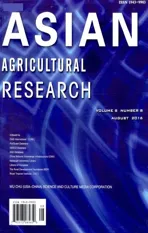ECSRE Analysis on Late Comer Strategy for Folk Custom Eco-tourism of Southeast Chongqing in the New Normal State
2016-01-12,
,
School of Business Administration, Chongqing University of Science and Technology, Chongqing 401331, China
1 Introduction
Southeast Chongqing includes Qianjiang District, Wulong County, Pengshui Miao and Tujia Autonomous County, Youyang Tujia and Miao Autonomous County, Xiushan Tujia and Miao Autonomous County, and Shizhu Tujia Autonomous County. Southeast Chong-qing, connected with Chongqing, Hubei, Hunan and Guizhou, is one of few areas where minority people (mainly Tujia and Miao people) live. Southeast Chongqing is rich in ecological resources and diversified ecological and folk culture, and is listed into national key ecological function zones and key bio-diversity protection zones. Southeast Chongqing is situated in hinterland of Wuling Mountain area, and intersection of Changjiang River Three Gorges, Zhangjiajie, ancient city of Phoenix, Wuling Mountain and Fanjing Mountain, which are three world level golden triangle tourism, and is reputed as a low lying land by the tourism field. In recent years, this area successfully rises through advantages of late development and becomes stamina of tourism development of Chongqing. Compared with tourism developed areas with relatively balanced market structure, the late development of tourism in southeast Chongqing is also faced with external environment which has experienced profound changes, so the survival environment is more complex and it is difficult to grasp uncertain factors. Uncertain development environment contains huge commercial opportunities, and also has big market risks.
The five element strategic analysis model (ECSRE) is based on understanding of complex features of China’s economic and social development in transition period, especially in-depth survey of market development situation and development rules of different types of enterprises, and it fully reflects characteristics of China’s economy and enterprises in the economic transition period[1]. ECSRE refers to enterprise, characteristic, stage, resource, and environment[2]. In this study, we employed these five elements to analyze tourism development in southeast Chongqing, and determined three key factors: attribute of the tourist site, development stage, and manager characteristic, to apply the ECSRE model into development strategy of tourist site and give prominence to its utility in refinement of tourism strategy in the period of economic transition.
2 Five element analysis on tourism industry in southeast Chongqing
2.1AnalysisonattributeoftourisminsoutheastChongqing
For tourist sites with different attribute, the strategies and business modes should manifest different characteristics. The attribute of tourist site includes many aspects, such as legal attribute, property right attribute, industry attribute, industry pattern attribute, organization attribute, and space attribute. From the perspective of legal attribute and property right attribute, segmented management system is endogenous obstacles to consolidated tourism development of southeast Chongqing. Tourism resource development is difficult, and it leads to dismemberment of trans-regional tourism resources and short-distance repeated development and construction of similar resources. From the perspective of industry attribute, economy-oriented tourism development outlook seriously affects and restricts sustainable development of tourism industry in ethnical regions. Southeast Chongqing is determined as an ecological protection development zone, but because policies are not specific, input is not perfect, and transfer payment is inadequate, it is still difficult to change the economy-oriented thinking mode in short term. From the perspective of space attribute, tourist site of southeast Chongqing is scattered in space. Apart from simple point and axle connection with tourist source areas, dotted polar problem and axial integrated structure start to appear. Establishing tourist transportation system, building tourist traffic, improving spatial network structure are effective ways of realizing spatial organization of southeast Chongqing[3]. From the perspective of industry pattern and organization attribute, new trend of tourism industry pattern becomes obvious in recent years, especially new technology, new equipment, industrial integration pattern, new type electronic business entities and new commercial mode. Networking organization of tourist enterprises and integration and combination of industries become evolution of China’s tourism industrial organizations and strategic direction of late comers in southeast Chongqing.
2.2AnalysisoncharacteristicsoftourismmanagersinsoutheastChongqingCompetition mode of tourist site largely reflects understanding and behavior of decision makers to enterprise market and competition,i.e. characteristics of tourism managers. Tourism development of southeast Chongqing is mainly led by local government, and operated by enterprises, and financial input is major fund source for tourism construction in southeast Chongqing. Such single government leading tourism mode renders individual characteristics and ability of decision makers to become essential factors for tourism development in southeast Chongqing. In the period of measuring government performance with GDP, getting instant results is idea of most government decision makers. Besides, technology imitation leads to homogeneous operation methods. Most tourist sites in "one district and four counties" of southeast Chongqing focus on income from tickets, but neglects associated and derived products of original tourist products. In addition, each region performs separately and lacks effective cooperation. These jointly restrict the scale effect of folk tourism. All of these are points to be considered in the development of tourism of southeast Chongqing in the new normal state.
Table1StatisticsoftourisminsoutheastChongqingin2008-2013

RegionNumberoftouristsreceived200820092010201120122013Comprehensivetourismincome∥108yuan200820092010201120122013QianjiangDistrict86.53112.60180.40253.00314.00416.702.363.575.508.0610.7014.38YouyangCounty38.0054.80101.50260.50465.00600.001.081.663.208.3015.0020.01PengshuiCounty46.5060.00100.00220.00340.00554.000.751.002.005.0010.0016.60ShizhuCounty45.0070.00250.00305.11400.06470.001.202.1012.5015.2520.0023.50WulongCounty220.00470.001018.001329.001616.001750.0011.0023.1250.0265.7281.0088.07XiushanCounty35.1045.2062.6780.60150.00152.000.901.162.003.006.006.30Total471.10812.601712.602448.003285.003943.0017.2932.6175.22105.33142.70168.86
2.3AnalysisondevelopmentstageoftourisminsoutheastChongqingTourist sites in different development stages have different organization characteristics, so the starting point of strategies and available space should be varied. According to Table 1, in 2008-2013, the folk custom eco-tourism of southeast Chongqing took on leap-forward development. The number of tourists received in southeast Chongqing grew from 4.7113 million in 2008 to 39.427 million in 2013, total tourism income rose from 1.729 billion yuan in 2008 to 16.886 billion yuan in 2013, growing about 8.37 times and 9.77 times respectively. Besides, the percentage of total tourism income to regional GDP rose from 3% in 2008 to 13% in 2013, increasing about 10 percentage points. All of these give prominence to tourism industry becoming new highlight in economic development of southeast Chongqing, and tourism industry has become a strategic pillar industry of southeast Chongqing. By contrast, Chongqing Municipality received 354 million tourists and obtained comprehensive tourism income up to 184.949 billion yuan in 2013. Southeast Chongqing took up 11% and 9% of Chongqing respectively because tourism in southeast Chongqing started late and it was subjected to competition of surrounding areas. As for the space structure of tourism in southeast Chongqing, it takes on discrete distribution and dotted polarization. As shown in Fig. 1, Wulong County outshone others relying on its world heritage, but its radiation effect on surrounding areas is not significant. As to tourism income structure of southeast Chongqing, the per capita tourist consumption of Wulong County is 500 yuan, and the per capita tourist consumption of other district and counties is 300-400 yuan (as shown in Fig. 2), mainly consisting of ticket fees and traffic and catering accommodation. The difference of per capita tourist consumption in southeast Chongqing lies mainly in the number of scenic spots and ticket fees. The per capita tourist consumption of Wulong County is about equal to that of Chongqing Municipality in 2013 (522.5 yuan), but lower than the average national level (806 yuan), much lower than consumption of domestic tourists in east China and Southeast Asia (1288 yuan), Hong Kong and Macau (2511 yuan), and European and American Countries (22980 yuan). These indicate that the growth mode of tourism in southeast Chongqing and even Chongqing Municipality still remains the extensive management with number expansion as the major part.

Fig.1ComprehensivetourismincomeofdistrictandcountiesinsoutheastChongqingin2008-2013

Fig.2PercapitatouristconsumptionofdistrictandcountiesinsoutheastChongqingin2008-2013
2.4AnalysisontourismresourcesofsoutheastChongqingResources of tourist site determine content of tourism development, thus resources are basic conditions for strategy formulation and implementation. Southeast Chongqing is rich in tourism resources, integrating mountains, waters, forests, springs, caves, and rivers, and has 1500 single scenic spot, including 2 national 5A level scenic spots (Wulong Karst Tourist Area and Youyang Taohuayuan Scenic Area ), 7 national 4A scenic spots, 6 national forest parks and 7 city level nature reserves, as listed in Table 2. Southeast Chongqing is the only minority area in municipalities directly under the Central Government, and also the largest folk custom eco-tourism area in Chongqing. This area has rich and colorful natural landscape and genuine folk customs. Besides, it is main region for Tujia People and Miao People. Its cultural connotation is deep and red tourism resources are abundant, and nonmaterial cultural heritage is unique. In the tide of tourism development, homogeneous problem of scenic spots gradually appears. Data indicate that there are 1780 new single tourism resources in southeast Chongqing in recent 5 years. In these new single natural resources, canyons and karst caves account for more than 70%; in newly explored cultural resources, Miao People and Tujia People folk customs and ancient towns account for about 70%. This not only leads to repeated construction, waste of funds and resource destruction, but also leads to aesthetic fatigue of tourists.
Table2TourismresourcesofsoutheastChongqing

TypeNumberScenicspot5Ascenicspot2WulongKarstTouristArea,YouyangTaohuayuanScenicArea4Ascenicspot7QianjiangSmallSouthSea,YouyangGongtanAncientTown,ShizhuDafengbaoScenicArea,PengshuiAyiRiverScenicArea,QianjiangPuhuaRiverScenicArea,YouyangLongtanAncientTownScenicArea,QianjiangZhu-oshuiAncientTownScenicAreaNationalforestpark6TheFairyMountainNationalForestPark,QianjiangNationalForestPark,HuangshuiNationalForestPark,QianjiangYangtouMountainForestPark,YouyangQinghuaMountainForestPark,andYouyangJinyinMoun-tainNationalForestParkCitylevelnaturereserve7QianjiangWulingMountain,QianjiangSmallSouthSea,WulongBaimaMountain,YouyangDabanying,ShizhuDafengbao,XiushanTaiyangMountain,XiushanSunMountain,PengshuiChangxiRiver
2.5AnalysisonexternalenvironmentoftourisminsoutheastChongqingIn analysis on external environment, it is required to pay special attention to changes in factors closely related to tourism. These changes usually contain great opportunities and threats for tourism development. Success of many tourist sites is based on adapting to social and economic changes. In the new normal state, tourism development of southeast Chongqing has opportunities and threats. Apart from intense industrial competition, general environment (such as domestic and foreign political, economic, social, cultural, and scientific and technological environment) also exerts sustained and profound effect on tourism development of southeast Chongqing, as listed in Table 3.
Table3AnalysisonexternalenvironmentoftourisminsoutheastChongqing
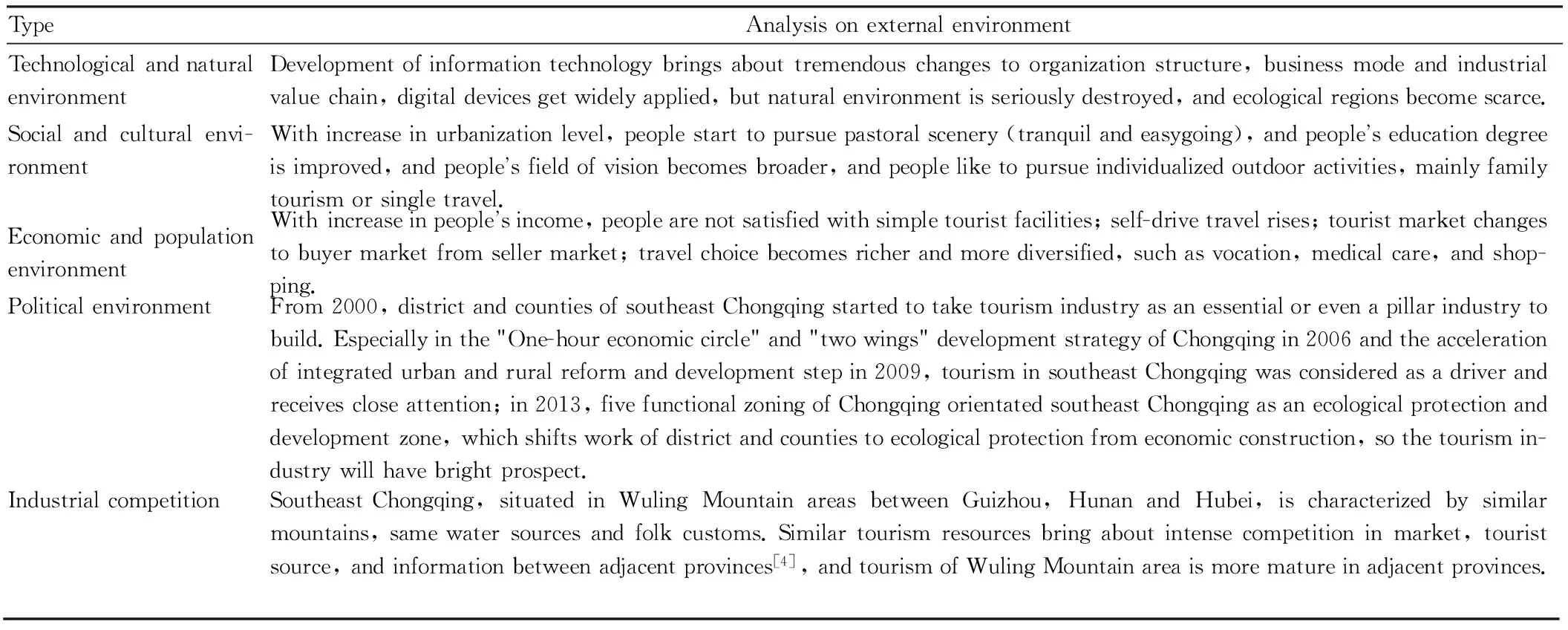
TypeAnalysisonexternalenvironmentTechnologicalandnaturalenvironmentDevelopmentofinformationtechnologybringsabouttremendouschangestoorganizationstructure,businessmodeandindustrialvaluechain,digitaldevicesgetwidelyapplied,butnaturalenvironmentisseriouslydestroyed,andecologicalregionsbecomescarce.Socialandculturalenvi-ronmentWithincreaseinurbanizationlevel,peoplestarttopursuepastoralscenery(tranquilandeasygoing),andpeopleseducationdegreeisimproved,andpeoplesfieldofvisionbecomesbroader,andpeopleliketopursueindividualizedoutdooractivities,mainlyfamilytourismorsingletravel.EconomicandpopulationenvironmentWithincreaseinpeoplesincome,peoplearenotsatisfiedwithsimpletouristfacilities;self-drivetravelrises;touristmarketchangestobuyermarketfromsellermarket;travelchoicebecomesricherandmorediversified,suchasvocation,medicalcare,andshop-ping.PoliticalenvironmentFrom2000,districtandcountiesofsoutheastChongqingstartedtotaketourismindustryasanessentialorevenapillarindustrytobuild.Especiallyinthe"One-houreconomiccircle"and"twowings"developmentstrategyofChongqingin2006andtheaccelerationofintegratedurbanandruralreformanddevelopmentstepin2009,tourisminsoutheastChongqingwasconsideredasadriverandreceivescloseattention;in2013,fivefunctionalzoningofChongqingorientatedsoutheastChongqingasanecologicalprotectionanddevelopmentzone,whichshiftsworkofdistrictandcountiestoecologicalprotectionfromeconomicconstruction,sothetourismin-dustrywillhavebrightprospect.IndustrialcompetitionSoutheastChongqing,situatedinWulingMountainareasbetweenGuizhou,HunanandHubei,ischaracterizedbysimilarmountains,samewatersourcesandfolkcustoms.Similartourismresourcesbringaboutintensecompetitioninmarket,touristsource,andinformationbetweenadjacentprovinces[4],andtourismofWulingMountainareaismorematureinadjacentprovinces.
2.6ResultsoffiveelementanalysisAccording to five element analysis, folk custom eco-tourism of southeast Chongqing has prominent strengths and weaknesses, as shown in Table 4. Strengths of tourism in southeast Chongqing are mainly manifested in its own quality and policy support, which should be protected through institutional innovation; weaknesses of tourism are mainly reflected in development degree and trend. Ecology of southeast Chongqing suffered serious destruction, and resources are not fully developed, such late development advantage contains tremendous business opportunities. Lieberman and Montgomery held that late development advantage lies mainly in hitchhiking effect of late comers, avoidance of mistake of first mover, and easy for innovation[5]. However, economist Watson stated that late development regions can obtain rapid development in short time through technology imitation, thus managers often pay attention to technology imitation but neglects institutional imitation. If late comers only care about technology imitation but belittle institutional imitation, their long-term development may fall into the trap of "curse to the late comer"[4-6]. In other words, tourism development in southeast Chongqing must attach great importance to reform and innovation, to ensure long-term benign play of its late comer advantages.
Table4StrengthsandweaknessesoffiveelementsfortourismdevelopmentinsoutheastChongqing
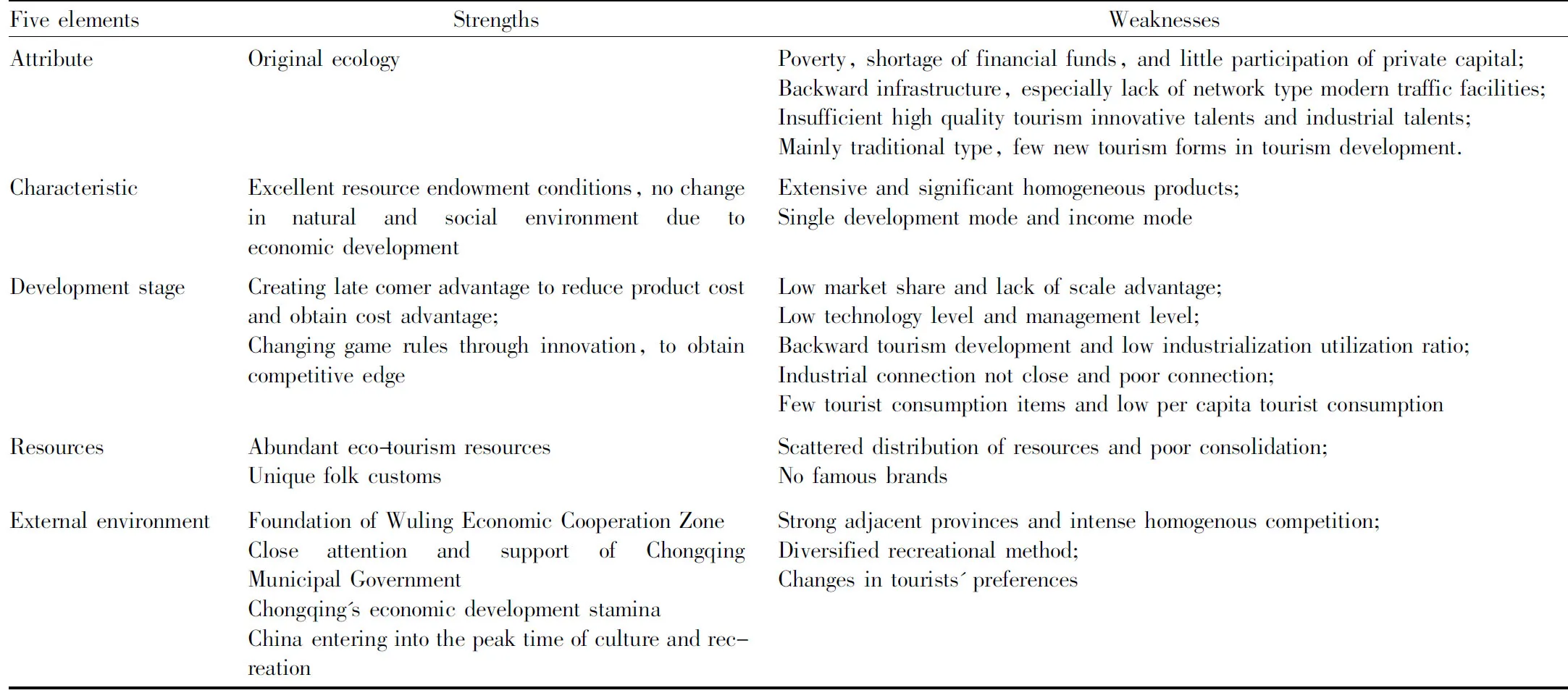
FiveelementsStrengthsWeaknessesAttributeOriginalecologyPoverty,shortageoffinancialfunds,andlittleparticipationofprivatecapital;Backwardinfrastructure,especiallylackofnetworktypemoderntrafficfacili-ties;Insufficienthighqualitytourisminnovativetalentsandindustrialtalents;Mainlytraditionaltype,fewnewtourismformsintourismdevelopment.CharacteristicExcellentresourceendowmentconditions,nochangeinnaturalandsocialenvironmentduetoe-conomicdevelopmentExtensiveandsignificanthomogeneousproducts;SingledevelopmentmodeandincomemodeDevelopmentstageCreatinglatecomeradvantagetoreduceproductcostandobtaincostadvantage;Changinggamerulesthroughinnovation,toobtaincompetitiveedgeLowmarketshareandlackofscaleadvantage;Lowtechnologylevelandmanagementlevel;Backwardtourismdevelopmentandlowindustrializationutilizationratio;Industrialconnectionnotcloseandpoorconnection;FewtouristconsumptionitemsandlowpercapitatouristconsumptionResourcesAbundanteco-tourismresourcesUniquefolkcustomsScattereddistributionofresourcesandpoorconsolidation;NofamousbrandsExternalenvironmentFoundationofWulingEconomicCooperationZoneCloseattentionandsupportofChongqingMunici-palGovernmentChongqingseconomicdevelopmentstaminaChinaenteringintothepeaktimeofcultureandrecreationStrongadjacentprovincesandintensehomogenouscompetition;Diversifiedrecreationalmethod;Changesintouristspreferences
3 Strategies for folk custom eco-tourism development of southeast Chongqing
3.1Raisingdevelopmentconceptoffolkcustomeco-tourismofsoutheastChongqingonthebasisofregionalcooperationTo realize substantial progress in cooperation, all areas of southeast Chongqing should unify understanding and intensify three kinds of awareness. (i) Market awareness. It is recommended to turn resources into characteristic products, change products into commodities desired by tourists through services, and make great achievements with the aid of blue mountains and green waters in southeast Chongqing, avoiding rough processed products. (ii) Industry awareness. Tourism industry is a pillar industry of southeast Chongqing. To develop tourism industry, it is recommended to cultivate brands and industry clusters, and establish connection of industrial chain, and also pay attention to industry upgrade and interaction. Especially, it is recommended to establish tourism interaction between Chongqing downtown and southeast Chongqing. (iii) Big marketing awareness. Boards of "City of Gorges and Rivers" of Qianjiang, "Impression Wulong" of Wulong, and "Land of Peach Blossoms" of Youyang are posted everywhere in district and counties of southeast Chongqing, but there is little overall promotion of tourism of southeast Chongqing. Like "Mysterious Western Hunan" and "Intoxicated with the Beauty of Guizhou", southeast Chongqing also needs an overall concept, taking tourism developing funds and unified brands as links, finally establishing government-leading, market operating, enterprise managing, and the public participating coordinated development pattern.
3.2ImplementingunifiedrestrictionwithecologicalandculturalprotectionasbasisDeveloping the tourism industry is an essential measure for sticking to the two bottom lines (ecology and development). Eco-tourism is a leading and pillar industry positioned by Chongqing Municipal Government and Party Committee. Southeast Chongqing should take the road of "orienting towards eco-tourism and integrating ecological industry, ecological agriculture and ecological towns" to get rid of poverty. This is a new road and there is no existing experience for reference. Therefore, it is a difficult problem to promote tourism development with limited financial resources on the basis of strengthening ecological protection. Despite this, southeast Chongqing should not commit the error of "first destruction then restoration", but should take the road of sustainable development, protect cultural space and time of the entire southeast Chongqing, and take the system and funds as guarantee to promote construction of cultural and ecological protection pilot zone. Besides, it is recommended to protect ancient buildings of southeast Chongqing and focus on protection of non-material culture such as folk customs, documents, and dialects.
3.3GivingcharacteristicsandscaleeffectandconcentratingonthemostimportantfieldsWith rich tourism resources and constant improvement in traffic facilities, southeast Chongqing is facing with great development period of tourism. At the same time, due to inborn defects, such as shortage of funds, weak infrastructure, and backward economy, the full flourish tourism development strategy is not suitable for local development. Southeast Chongqing should concentrate on building a "2+1" product form of sightseeing, recreation, and cultural experience of Karst eco-tourism, and put forth effort of upgrade of southeast Chongqing, and make effort to cultivate big projects, dislocated and differentiated development (Table 5). Tourism of southeast Chongqing has many highlights, such as Wujiang River Gorge in Pengshui, Taohuayuan in Youyang, Huangshui Forest Park in Shizhu, Puhua River in Qianjiang, Fairy Mountain in Wulong, and Biancheng in Xiushan. These scenic areas reflect folk custom ecological and natural landscape features of southeast Chongqing. In addition, it is recommended to strengthen the whole journey and whole area travel and give prominence to the scale effect. Specifically, taking highways and railways, national highway main lines radiated from Chongqing downtown as main axle, integrating administrative location, market position and resource distribution, and taking Tiankengdifeng world natural heritage as the center to build sightseeing tourism industry, it is expected to generate industrial cluster and scale effect, and establish supporting service system and improve cultural, recreation and shopping functions suitable for big tourism cycle (cycle between southeast Chongqing and Hunan Zhangjiajie, cycle between southeast Chongqing and Hubei Enshi, and cycle between southeast Chongqing and three gorges).
Table5MainpointsoftourismdevelopmentinsoutheastChongqing
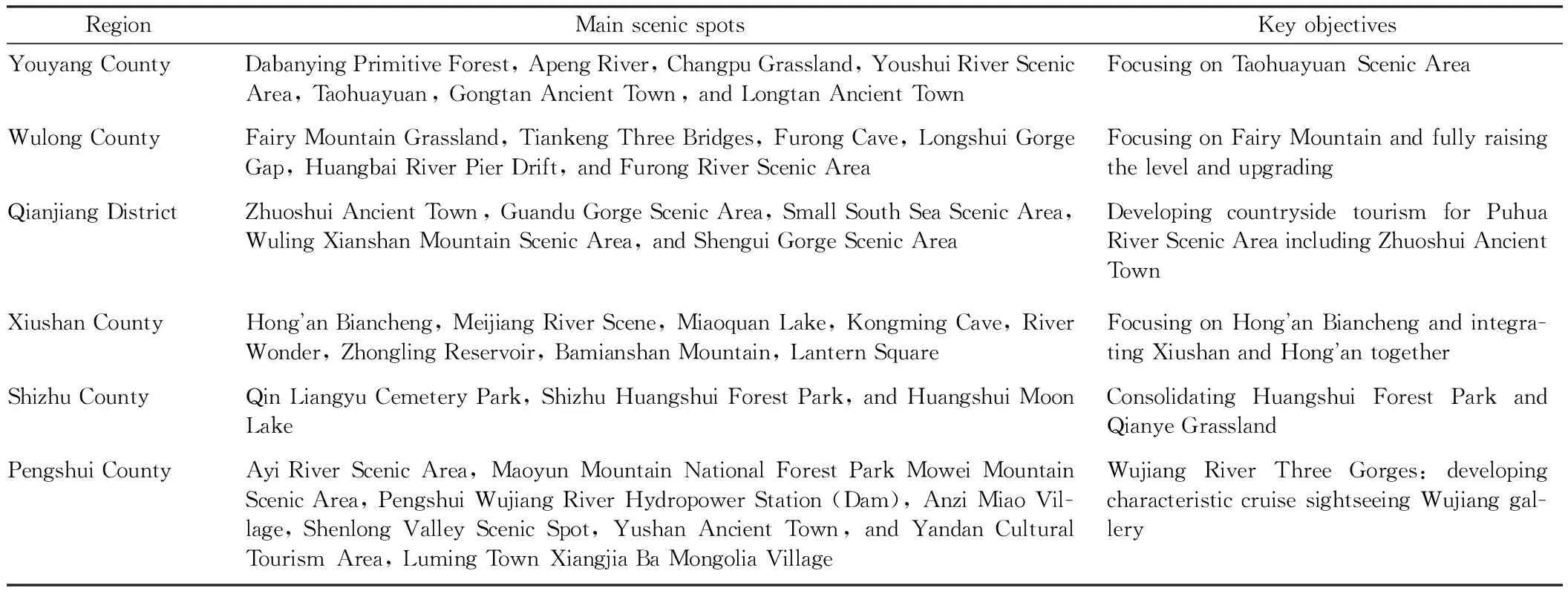
RegionMainscenicspotsKeyobjectivesYouyangCountyDabanyingPrimitiveForest,ApengRiver,ChangpuGrassland,YoushuiRiverScenicArea,Taohuayuan,GongtanAncientTown,andLongtanAncientTownFocusingonTaohuayuanScenicAreaWulongCountyFairyMountainGrassland,TiankengThreeBridges,FurongCave,LongshuiGorgeGap,HuangbaiRiverPierDrift,andFurongRiverScenicAreaFocusingonFairyMountainandfullyraisingthelevelandupgradingQianjiangDistrictZhuoshuiAncientTown,GuanduGorgeScenicArea,SmallSouthSeaScenicArea,WulingXianshanMountainScenicArea,andShenguiGorgeScenicAreaDevelopingcountrysidetourismforPuhuaRiverScenicAreaincludingZhuoshuiAncientTownXiushanCountyHonganBiancheng,MeijiangRiverScene,MiaoquanLake,KongmingCave,RiverWonder,ZhonglingReservoir,BamianshanMountain,LanternSquareFocusingonHonganBianchengandintegra-tingXiushanandHongantogetherShizhuCountyQinLiangyuCemeteryPark,ShizhuHuangshuiForestPark,andHuangshuiMoonLakeConsolidatingHuangshuiForestParkandQianyeGrasslandPengshuiCountyAyiRiverScenicArea,MaoyunMountainNationalForestParkMoweiMountainScenicArea,PengshuiWujiangRiverHydropowerStation(Dam),AnziMiaoVil-lage,ShenlongValleyScenicSpot,YushanAncientTown,andYandanCulturalTourismArea,LumingTownXiangjiaBaMongoliaVillageWujiangRiverThreeGorges:developingcharacteristiccruisesightseeingWujianggal-lery
Table6Developmentmodesforfolkcustomeco-tourisminGuizhou

Developmentmodesforfolkcustomeco-tourisminGuizhouWeaknessesRecommendationsGovernmentleadingmode:LeishanXijiangGovernmentdependent,andautonomousinno-vationofenterpriserestrictedRespectingandusingmarketrules[9]Communitycooperation(combination)mode:LeishanLangdePlightofindividualrationalityandcollectiveac-tionStrengtheningconstructionofcommunityorganizationsandintroducingexternalentities[10]Transfertypemanagementmode:MalingRiverCanyonRestrictedbyoperatingabilityandactionofmanagersCautiouslyreviewingqualificationofoperator,signinglong-termleasingcontract,andensuringcontinuityofscenicareadevelopment,operation,andmanagement[11]Entrustedmanagementmode:(Tianlongmode):AnshunTunbaoAuthorizationnotclearandcreditcrisisMakingclearauthorizationandestablishingsupervisionmechanism[11]ShareholdingcooperationmodeIndependentandhighefficientshareholdingen-terprisesnotestablishedImplementingde-administrationandbuildinginternalbalan-cingmechanism[12]
3.4PromotinginstitutionalreformandinnovationandselectingscenicareamanagementmodeaccordingtolocalconditionsSoutheast Chongqing is backward in western region, its scenic areas have many management parties and the problem of vacancy in management is serious, which is not favorable for development of tourism industry[7]. Breaking the bottleneck of scenic area management system is an urgent problem to be solved for tourism industry in southeast Chongqing[8]. With reference to 5 modes for fold custom eco-tourism development in Guizhou: government leading, community combination, transfer type management, entrusted management, and shareholding cooperative modes[7], there are successful cases and failure lessons in practice. The practice indicates that coordinating the benefits and relation between interested parties is an essential factor restricting the development of scenic areas, as listed in Table 6. For those provincial level of below scenic areas without taking the protection as primary purpose and without high scarcity, government should encourage overall transfer. It is recommended to promote innovation of thinking and tourism development methods through diversified tourism management modes and diversified talent introduction mechanism, and boost orderly operation of resource management in public scenic area through reasonable benefit allocation system.
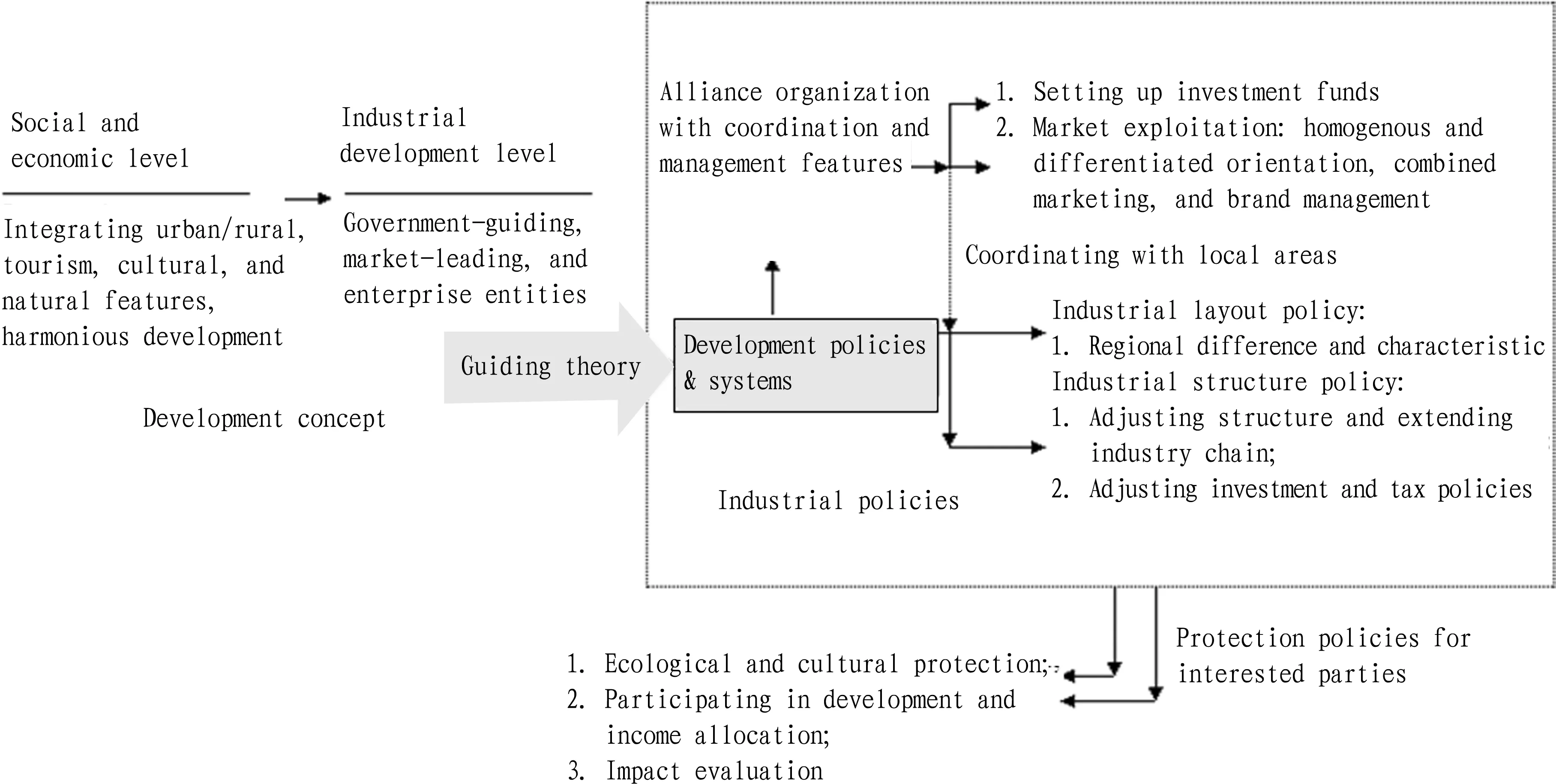
Fig.3Policiesandsystemsforpromotingfolkcustomeco-tourismdevelopmentinsoutheastChongqing
3.5Promotingfolkcustomeco-tourismdevelopmentinso-utheastChongqingthroughperfectpolicysystemAt present, in macro policies, southeast Chongqing has obtained great support of levels of government. However, due to influence of location and external competition, sustainable development of folk custom eco-tourism in southeast Chongqing still needs generous support of government, especially at levels of tourism industry development policy and management policy, as shown in Fig. 3. At the development concept of macro social and economic levels, southeast Chongqing still needs strengthening eco-tourism development road, integrating urban/rural, cultural, and natural features together, and promoting realization of new urbanization and rural poverty alleviation. At meso level of industrial development, it is recommended to establish permanent organizations with management and coordination features, make clear and strengthen their functions, and promote unified action of tourism in southeast Chongqing. Through incentive and restrictive action of series of development policies, it is expected to realize government guiding, marketing leading, and enterprise entities four-in-one development concept. In the design of specific policies and systems, consolidating poverty alleviation, new countryside construction, and new urbanization policies become support and interaction of tourism development in southeast Chongqing. Therefore, it is recommended to solve the problems of funds, brands, industrial integration and ecological and cultural protection mainly through policy optimization, transplantation and innovation, and realize in-depth development of folk custom eco-tourism in southeast Chongqing.
4 Conclusions
Five element strategic analysis model stresses intrinsic features of things, which is favorable for making clear weakness of late comers and suitable for southeast Chongqing in the new normal state. Using the five element analysis, on the basis of analyzing resources and external conditions, we made an in-depth analysis on late comer strategy for southeast Chongqing from the perspective of industry pattern attribute, development stages, individual characters and thinking pattern of decision-makers. We recommended promoting long-term rapid and sustainable development of folk custom eco-tourism in southeast Chongqing through institutional reform and policy and system construction. Although we stressed improving policy system, to stimulate strengths of late comers through regional cooperation, unified restriction, dislocation characteristics, institutional simulation and innovation, it is still necessary to be further study formulation and implementation of specific policies and improve policies and systems.
[1] WEN JL. Discussion on how to establish and implement development strategies of small businesses[J]. Modern Business,2012(3):167-168. (in Chinese).
[2] HE G. Study on the core competence of distribution industries under dynamic competition [D].Shanghai: Fudan University, 2013. (in Chinese).
[3] WANG ZJ, CHEN H. Dynamic mechanism and spatial variation of rural tourism in impoverished mountainous area——A case study of Southeast Chongqing [J]. Chinese Agricultural Science Bulletin,2014(20):316-320. (in Chinese).
[4] ZHANG GC. SWOT analysis on tourist economy of southeast Chongqing and the development strategies [J]. Economic Research Guide,2012(30):174-175. (in Chinese).
[5] LIEBERMAN MB, MONTGOME DB. First mover disadvantages: Retrospective and link with the resource-based view[J].Strategic Management Journal, 1989(20):164-182.
[6] WU YM, LI JX, XU JH. The effects of late comer: The disadvantages and advantages of the late comer-Implication to western China development[J]. Human Geography,2005(3):6-11. (in Chinese).
[7] GAO LJ. Thinking on the reform of scenic spot resource management system [N].China Tourism News, 2012-01-09015. (in Chinese).
[8] ZHANG JL. On the reform of the scenic area management system in Henan Province [J].Journal of North China Institute of Water Conservancy and Hydroelectric Power(Social Sciences Edition), 2011(5):101-104. (in Chinese).
[9] FEI GY, CHEN ZY. Study on the tourist development model of the government leadership in the nationality village community -take the Xijiang Qianhu Miao village as example [J]. Journal of Guizhou Educational College(Social Science Edition),2009(6):28-35. (in Chinese).
[10] CHEN ZY, KUANG ZG. The dilemma of individual rationality and collective activity in the community—Leading tourism development model of the Langde Miao Ethnic Village [J].Academic Exploration, 2009(3):72-79. (in Chinese).
[11] MA PF. The difficulties and solutions of scenic spot management under the new situation [N]. China Tourism News,2014-05-05. (in Chinese).
[12] ZHAO ZX.The enlightenment of corporate governance theories to tourist areas development and management of state-owned enterprises [J].Young & World,2014(10):106-106. (in Chinese).
杂志排行
Asian Agricultural Research的其它文章
- Empirical Analysis on Financial Development, Urbanization, and Urban and Rural Resident Income in Jiangsu Province
- Farmer’s Perception on Supply-Demand Matching of New Variety and Its Influence Factors
- Vegetation Coverage Changes in the West Qinling Region from 2000 to 2010: A Case Study of Longnan City
- A Study of Estimation Model for the Chlorophyll Content of Wheat Leaf Based on Hyperspectral Imaging
- A Study of Virtual Museum Simulation Platform Based on 2.5D Architectural Modeling Technology
- The Value Insistence of the Cultural Production in the Big Data Era
